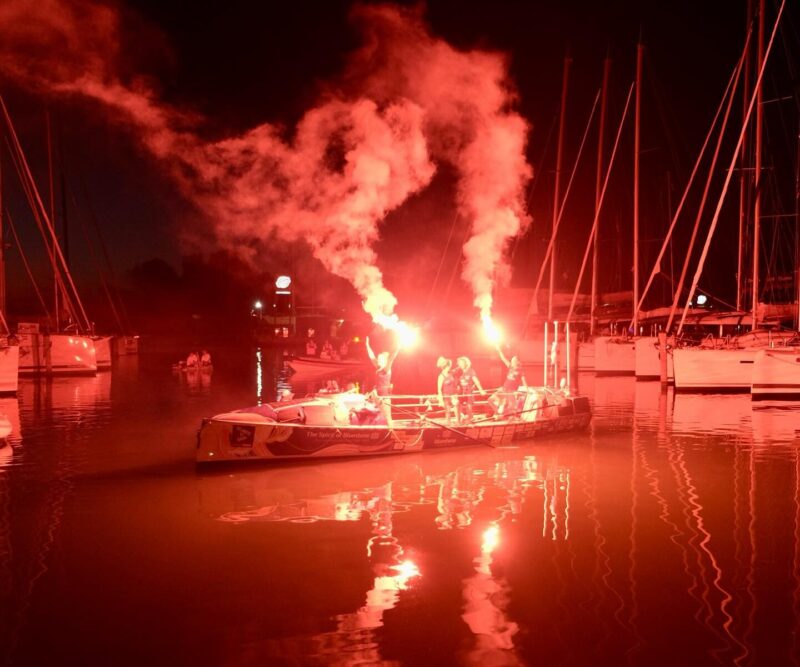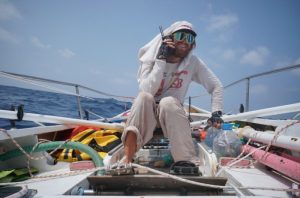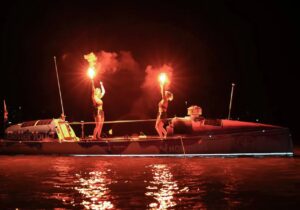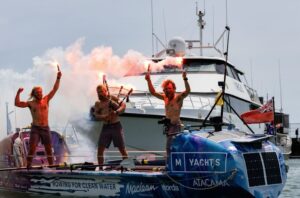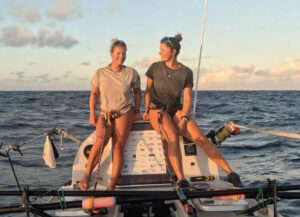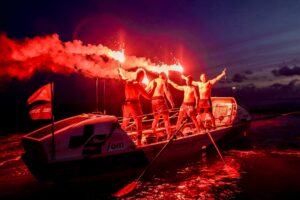Since our last ocean rowing roundup, all the crews on the Atlantic have completed their rows, and two fresh teams have taken to the Pacific.
Atlantic Ocean
Atlantic Dash: The Atlantic Dash calls itself an ocean-rowing regatta. Four teams took part in the 5,000km row from the Canary Islands to Antigua this year. Starting on February 1, all four boats had crossed the finish line by March 26.
The event organizers stressed that it was not a race, but the four crews were neck and neck to the finish, and all finished within 26 hours.
Waves to Awareness, with the pair Ruby Coates and Steffan Evans, finished first. Three hours later, soloist Gary Hutching landed in Antigua’s Jolly Harbour. Row For It, a four of Neil Glover, Peter Ross, Darren Smith, and Nick Southwood, finished the next day, followed by the all-female crew Cruising Free, consisting of Sophie Pierce, Janine Williams, Polly Zipperlen, and Miyah Periam.
Annasley Park (UK): Solo rower Annasley Park completed her Atlantic row on March 28. The former professional cyclist rowed from the Canary Islands to Barbados in 54 days, 14 hours, and 14 minutes.
At the start of her row, she battled sea sickness, strong winds, capsizes, and dust on her solar panels. As she rowed into March, conditions improved, and she picked up speed. This lasted a few weeks before it became clear that a weather system was going to start pushing her north. To counteract it, she took a more southerly line.
This helped, but Park still ended up on her para-anchor, trapped in her cabin.
“For safety reasons, the cabin door needs to be shut, but that means that Annasley [Park] is sitting inside a sealed fiberglass box, under the hot sun. Much like leaving someone in a car on a hot day with the windows shut,” her team wrote.
Once finally off the para-anchor, things went from bad to worse: Her autohelm (the link between her chart plotter and rudder) broke. After a day fiddling with the equipment and some frantic calls, she managed to fix it and start the final week of her row.
For the last few kilometers, Park whipped round the northern tip of Barbados in a huge squall.
Pacific Ocean
Seas the Day (UK): Jessica Rowe and Miriam Payne are rowing from Peru to Sydney, Australia. The pair started on April 8 and hopes to make it 14,000km across the Pacific in six months.
Rowe and Payne met in 2022 while taking part in the Talisker Whisky Atlantic Challenge (now called The World’s Toughest Row). Payne was taking on the race as a soloist, Rowe in an all-female four. Having connected before the row, they stayed friends and decided to embark on a joint project.
They were originally going to start their challenge in the middle of March, but this was pushed back to April 8. There were delays getting their boat and food through customs, and they then found a stress fracture in the hull.
The first few days felt like “rowing through treacle” because there was little wind. Then conditions changed dramatically, and they ended up on their para-anchor.
Assessing the boat after the bad weather, they noticed that the storm had damaged the rudder in four places. Days after leaving, the pair turned their boat around, and a rescue team towed them back to Peru. They will make repairs and restart as soon as possible.
The Maclean Brothers (UK): Three Scottish brothers, Ewan, Jamie, and Lachlan MacLean, are also rowing across the Pacific Ocean from Peru to Sydney, Australia.
The trio crossed the Atlantic in 2020, breaking the speed record for a three-man crew. On that expedition, they rowed from La Gomera in the Canary Islands to Antigua in 35 days.
Now they hope to do the same across the Pacific. They aim to cover 14,000km in 120 days by rowing in two-hour shifts around the clock. If they manage this, they will cut 42 days off the current record.
At just 280kg, their carbon-fiber boat is one of the lightest ocean rowing boats in the world.
In true Scottish style, they ate a haggis dinner the night before their departure, and packed haggis, neeps, and tatties to celebrate Lachlan’s 27th birthday while at sea.
Setting off a few days after Seas the Day, they are one week into their row. Already, they’ve had to contend with the usual early struggles, including seasickness and sleep deprivation. After a few days, they have regained their appetites but are struggling with salt sores on their backsides and a finicky autohelm.
